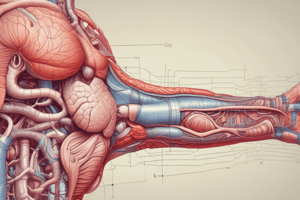Podcast
Questions and Answers
What is the primary function of the digestive system?
What is the primary function of the digestive system?
- To produce digestive enzymes
- To eliminate waste products from the lungs
- To absorb nutrients from the air
- To break down and absorb nutrients from food (correct)
Which organ is responsible for mechanical breakdown of food?
Which organ is responsible for mechanical breakdown of food?
- Pancreas
- Mouth (correct)
- Small Intestine
- Stomach
What is the role of the liver in the digestive process?
What is the role of the liver in the digestive process?
- To process and filter nutrients from the small intestine (correct)
- To absorb nutrients from food
- To eliminate waste products from the body
- To produce digestive enzymes
What is the main site of nutrient absorption in the digestive system?
What is the main site of nutrient absorption in the digestive system?
What is the function of the pancreas in the digestive system?
What is the function of the pancreas in the digestive system?
What is the term for the process by which nutrients are absorbed into the bloodstream?
What is the term for the process by which nutrients are absorbed into the bloodstream?
What is the term for the process by which enzymes break down nutrients into simpler molecules?
What is the term for the process by which enzymes break down nutrients into simpler molecules?
What is the term for the muscular contractions that propel food through the esophagus?
What is the term for the muscular contractions that propel food through the esophagus?
Flashcards are hidden until you start studying
Study Notes
Digestive System
Overview
- The digestive system is a complex process by which the body breaks down and absorbs nutrients from food
- Involves mechanical and chemical breakdown of food, absorption of nutrients, and elimination of waste products
Organs of the Digestive System
- Mouth:
- Food is chewed and mixed with saliva that contains enzymes to break down carbohydrates
- Swallowing transports food to the esophagus
- Esophagus:
- Muscular tube that propels food to the stomach through peristalsis
- Stomach:
- Food is mixed with stomach acid and digestive enzymes to break down proteins and fats
- Gastric juices contain pepsin and hydrochloric acid
- Small Intestine:
- Most nutrient absorption occurs here
- Walls are lined with finger-like projections called villi, increasing surface area for absorption
- Nutrients are absorbed into bloodstream and transported to liver for processing
- Pancreas:
- Produces digestive enzymes and bicarbonate-rich fluids to neutralize stomach acid
- Liver:
- Processes and filters nutrients from small intestine
- Regulates glucose levels and stores glycogen
- Large Intestine (Colon):
- Water and electrolytes are absorbed, and waste is prepared for elimination
- Houses trillions of microorganisms, the gut microbiome
Digestive Processes
- Mechanical Breakdown:
- Chewing and grinding of food in the mouth
- Contractions of stomach muscles to mix food with digestive enzymes
- Chemical Breakdown:
- Enzymes break down carbohydrates, proteins, and fats into simpler molecules
- Hydrolysis reactions cleave chemical bonds, releasing nutrients
- Absorption:
- Nutrients are absorbed into bloodstream through intestinal walls
- Transported to liver for processing and distribution to the body
Digestive System
Overview
- The digestive system is responsible for breaking down and absorbing nutrients from food, involving mechanical and chemical breakdown, absorption, and waste elimination.
Organs of the Digestive System
- Mouth:
- Breaks down carbohydrates through chewing and mixing with saliva containing enzymes
- Food is swallowed, transporting it to the esophagus
- Esophagus:
- Propels food to the stomach through peristalsis, a muscular tube action
- Stomach:
- Mixes food with stomach acid and digestive enzymes to break down proteins and fats
- Gastric juices contain pepsin and hydrochloric acid
- Small Intestine:
- Most nutrient absorption occurs here, with walls lined with villi for increased surface area
- Absorbed nutrients are transported to the liver for processing
- Pancreas:
- Produces digestive enzymes and bicarbonate-rich fluids to neutralize stomach acid
- Liver:
- Processes and filters nutrients from the small intestine
- Regulates glucose levels and stores glycogen
- Large Intestine (Colon):
- Absorbs water and electrolytes, preparing waste for elimination
- Houses trillions of microorganisms in the gut microbiome
Digestive Processes
- Mechanical Breakdown:
- Involves chewing and grinding food in the mouth
- Stomach muscles contract to mix food with digestive enzymes
- Chemical Breakdown:
- Enzymes break down carbohydrates, proteins, and fats into simpler molecules
- Hydrolysis reactions cleave chemical bonds, releasing nutrients
- Absorption:
- Nutrients are absorbed into the bloodstream through intestinal walls
- Nutrients are transported to the liver for processing and distribution to the body
Studying That Suits You
Use AI to generate personalized quizzes and flashcards to suit your learning preferences.




